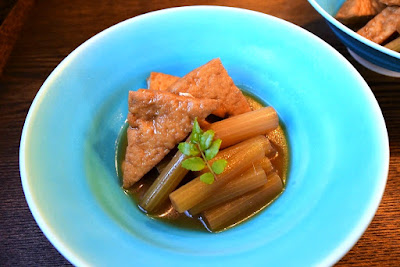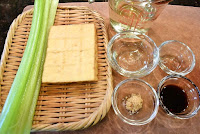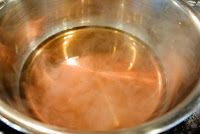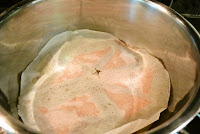104 calories (1/2 of recipe); 6.7 g protein; 6.6 g fat; 3.2 g carbohydrate; 2.3 g net carbs; 95 mg sodium (with 50% reduced-sodium soy sauce); 0 mg cholesterol; 0.9 g fiber
<Ingredients>
1 atsuage deep-fried tofu (prep-boiled; 115 g in photo)
For broth
150 cc dashi
2 tsp sake
1 tsp mirin
1/3 tsp brown sugar
1 1/2 tsp soy sauce
1/4 tsp rice vinegar
Kinome young sansho leaves (for garnish; not in photo)
<Directions>
1.
Cut fuki into 3-4 cm.
Cut atsuage into 8 triangles or squares.
2.
In a pot, put all ingredients for broth, and start to heat.
3.
Put atsuage in a single layer (without overlapping), place otoshibuta drop-cover directly on top, and simmer on low heat for 10-15 minutes.
Flip atsuage once for even flavoring while simmering.
4.
Add fuki, cover with otoshibuta again, and simmer for another 5 minutes.
Remove from heat, and let cool in broth for a few hours to overnight.
(Preheat before serving.)
<Notes>
- Nutrition figures above are based on the assumption that 60% of broth is absorbed by atsuage and fuki.
- Actual calories and fat content are likely 10-15% less than the above figures, as oil on the atsuage surface is partially removed in the prep process.
- Atsuage's size/weight varies by manufacturer, and the above product is on the small end.
- This dish tastes good hot or at room temperature. Saltiness is more clearly sensed when food is hot, and compared to the original version, this recipe would taste weak when served cold.










No comments:
Post a Comment